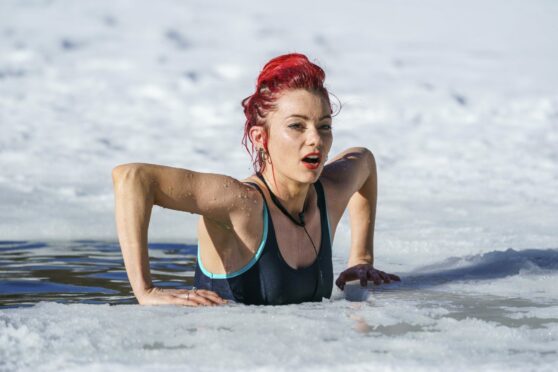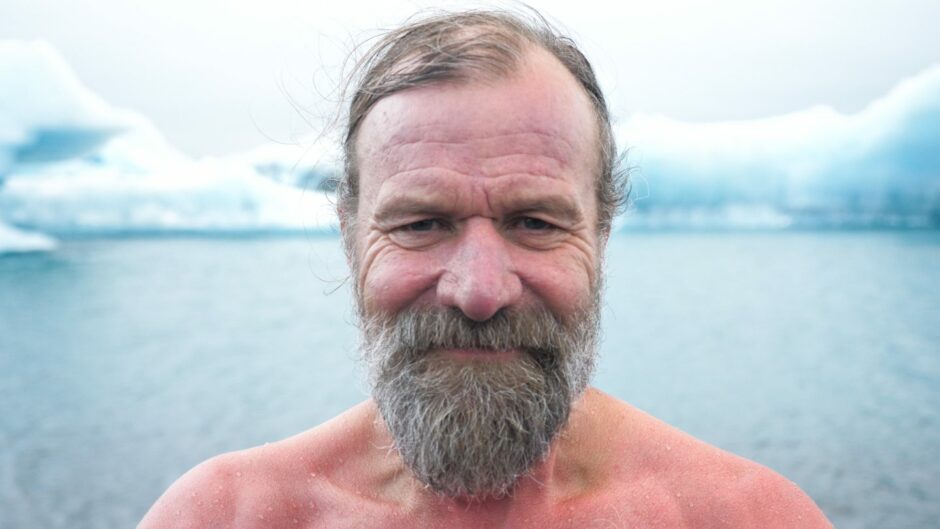
Jumping into ice-cold water and falling a terrifying 500 feet from a bridge in sub-zero conditions in the Italian mountains, doesn’t sound like our idea of a good time.
But Dianne Buswell describes her time on reality show Freeze The Fear With Wim Hof as positively life-changing.
The flame-haired Strictly dancer says she uses the lessons she learned from the Dutch motivational speaker and extreme athlete – also known as The Iceman – to cope with anxiety.
“I feel like I really changed from the beginning. The breathing technique is something I genuinely practise daily now,” says the 33-year-old. Hof’s technique involves fully inhaling deeply through the nose or mouth (using the belly, then chest) and exhaling unforced through the mouth – and repeating it 30 to 40 times in short, powerful bursts. After the last inhalation, he suggests letting the air out and stopping breathing until you feel the urge to breathe again.
Buswell says she does the technique prior to dance shows especially.
“There are thousands of eyes watching you dance – and that can be a little bit overwhelming.
“But I’ve done all my breathing since starting this tour and I’ve not felt anxious out there once. I’ve just gone out and enjoyed every moment.”
The power of the cold – and the positive impact it’s said to have on circulation, metabolism, inflammation, immunity and sleep – has also carried over into Buswell’s everyday routine too. Now she has a cold shower every morning and jumps in an ice bath after dancing. She says: “I love it. I really look forward to it – before I was like, ‘Oh, there’s no chance I’m doing that – don’t be daft!’”
Viewers were emotional when Buswell,who has been dating YouTuber Joe Sugg since 2018, opened up to other celebrities on the BBC show about struggling with an eating disorder in her early 20s – sparked by body image pressure and enforced weigh-ins as a young dancer. Her weight prompted doctors to warn she was at risk of a heart attack.
“It was probably about a solid year that it was happening,” the dancer, originally from Western Australia, says. “I was definitely underweight and my body was under extreme stress. I felt like I needed to look a certain way and I restricted myself.”
Her illness impacted her love of dancing, as well as her ability to dance. “My body wasn’t coping with the amount of pressure being put on it. I was tired, I didn’t have energy, my mood wasn’t there, I didn’t want to dance. Normally, the music would just take me to this other place, like when I’m on stage, I see the joy. But when I wasn’t feeling at my best, I had to act to enjoy it.”
But she says she was “lucky” in a way. Although she saw doctors, she didn’t have to go to a specialised clinic and, with the support of her family, was able to recover. “I’m very strong-minded and realised I wasn’t happy with how I was feeling and how my body was feeling. My brain was then able to go, ‘I really want to keep dancing and I really want to be strong and healthy’. I took time off to recover and get my body strong again. I was really lucky in that sense. I realise it’s not the case for everyone.”
Now she says she’s “in a much better place” with her own body image. “I’m happy. I don’t judge myself against anyone else. I always just think about me, myself and I, and what my body needs for it to feel good. I’m always telling myself we’re all so different – so I don’t need to look like anyone else but myself.”
And she’s discovered the power of talking to a professional – even when you don’t have problems. “I’m not afraid to say I speak to a therapist every now and then. It’s not because I feel I have issues, but I think we do yoga to stretch our bodies and we go for massages to relieve tension – but I think it’s good to also work out your brain.”
These days Buswell is “big into self-care” although she explains: “I used to find it quite a selfish thing, so I never used to do it, but now it’s the most important thing – because if you feel good about yourself then you give other things so much more time and energy, and you have the time and energy to do it!”
She likens her regularly doing yoga and Pilates to going for a massage or a facial. She said: “When you’re relaxed, you really enjoy a massage – that’s how I feel when I do yoga. I light candles, I make it a really nice place – it’s self-care as well as obviously doing good things for your body.”
And acts of self-care can really be anything that makes you feel good. “One of my favourites is going to a market and buying really nice fruit and veg. To me, it’s a form of self-care, because I enjoy the market and shopping for food, and I enjoy getting home, and cooking it.”
She adds: “I’ll try to have some sort of yoghurt every day. I tend to snack a fair bit when I’m touring, because I can’t cook as much as I want to. I love rice cakes and almond butter or peanut butter. I love avocado on basically everything, fruits like bananas and oranges, loads of different nuts… I’ve always got a bag of snacks with me.
“That’s part of my thing – I’m the snack queen!” she laughs. “If anyone’s ever hungry – Dianne’s got you sorted.”
If you’re worried about your own or someone else’s health, contact eating disorder charity Beat on 0808 801 0677 or visit beateatingdisorders.org.uk.
The Iceman cometh to recover your inner power

He’s known as the Iceman, thanks to his ability to withstand sub-zero temperatures.
He believes we have lost touch with our natural environment and therefore our inner power.
But by adopting Wim Hof’s three-step method – breathing, cold therapy and commitment – we can reconnect with ourselves, others and with nature.
The first step in the Wim Hof Method is breathing. We’re always breathing, yet mostly unaware of its tremendous potential to unlock more energy, reduce stress levels and provide an augmented immune response.
Hoff’s special breathing technique tells us to get comfortable, close our eyes and clear our minds, then take 30-40 deep breaths. After the last exhalation, inhale one final time as deeply as you can then let the air out. Finally, take a recovery breath, holding for around 15 seconds.
This is your training for step two – cold therapy.
Scientists have found that exposure to cold speeds up metabolism. Another benefit is that it reduces inflammation, swelling, and sore muscles. Therefore, many athletes use ice baths and other types of exposure to cold as a means to speed up recovery. Cold body therapy is also linked to improved quality of sleep, more focus, and an improved immune response.
Finally, you’ll need commitment as conscious breathing and cold therapy require patience and dedication. Hoff suggests ice baths and cold showers can have huge health benefits
Through meditation and conscious breathing you can observe your emotions and impulses, without identifying or acting on them.

Enjoy the convenience of having The Sunday Post delivered as a digital ePaper straight to your smartphone, tablet or computer.
Subscribe for only £5.49 a month and enjoy all the benefits of the printed paper as a digital replica.
Subscribe